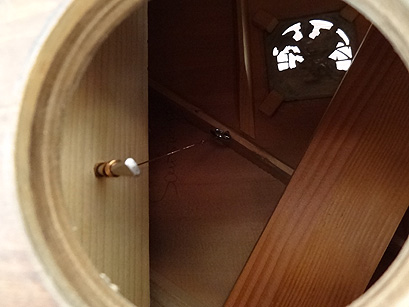Technical Library
STRUCTURE III: Wayward soundboards
Entire Contents Copyright © 2011 CBHTechnical LibrarySTRUCTURE III: Wayward soundboards Entire Contents Copyright © 2011 CBH |
Soundboard warp…
Good harpsichord makers today have much greater success during the construction process at controlling the future behaviour of the flexible soundboard membrane. This thin panel of softwood is the heart of the instrument, and can easily misbehave. Most soundboard problems are caused by extremes of humidity in combination with the string tension: The wood of the soundboard has no choice but to expand with increase of humidity, whereas the relatively rigid perimeter of the case stays put.
Hopefully, the 8´ bridge rises with humidity. If the 8´ bridge drops, however, its strings might lose downbearing completely in the treble and buzz or even fully rest on the 4´ bridge in the tenor and bass. The instrument becomes unplayable.
In a usual Flemish or 18th-century French harpsichord, the area near the rose is normally kept flat by the chosen system of ribbing. If ribbed insufficiently, in times of high humidity a tall profile cast metal rose itself can foul the 4´ strings when that area of the board rises.
To control soundboard behaviour, certain historic harpsichords have additional ribs fitted where not expected. In the early years of the harpsichord revival, more than one surviving instrument was rendered unplayable by its well-intentioned restorer removing these ribs because they didn’t conform to their idea of the norm.
Today, we can add support to the underside of the soundboard by fitting appropriate ribs like the makers of the past. Some makers advocate the use of ”happiness bars”, which are spring-topped dowels permanently installed to uplift a sagging bridge. It’s a shame if a maker had to resort to this remedy on an instrument even before it left the workshop. Out in the field, a simple solution is often to tie a wayward area of the board down. This can easily be provided with a means of adjustment.
 |
An adjustable turnbuckle was then fitted to the 4´ cutoff bar to control the rise in the 4´ bridge at times of highest humidity, and a square coverplate screwed over the bottom hole to complete the job.
|
||
| Tiedown with adjustable turnbuckle |
This instrument in San Juan had insufficient clearance between the tenor 8´ strings and the 4´ bridge. The most effective position for tiedown was determined by applying pressure from the top directly over the 4´ cutoff bar. A ø72mm hand hole could then be cut in the bottom, clear of internal bracing. A simple hook was screwed into the cutoff bar and a phosphor bronze wire dropped to determine a hole position in a bottom brace for a tuning pin, enabling ease of adjustment in the future. Finally, a square coverplate was screwed over the bottom hole. |
 |
| 4´ cutoff bar tied down with simple tuning pin adjustment |
 |
A maker had to raise the height of the 4´ bridge on this French Double harpsichord because it had dropped so much that the 4´ strings from the tenor down were touching the soundboard. This fix has been quite neatly done with a walnut strip glued on top of the beech of the bridge. Of course, it would have been preferable not to have the soundboard deform quite so much. |
| 4´ bridge height extension |
| Technical Library overview | |
| Harpsichords Australia Home Page |